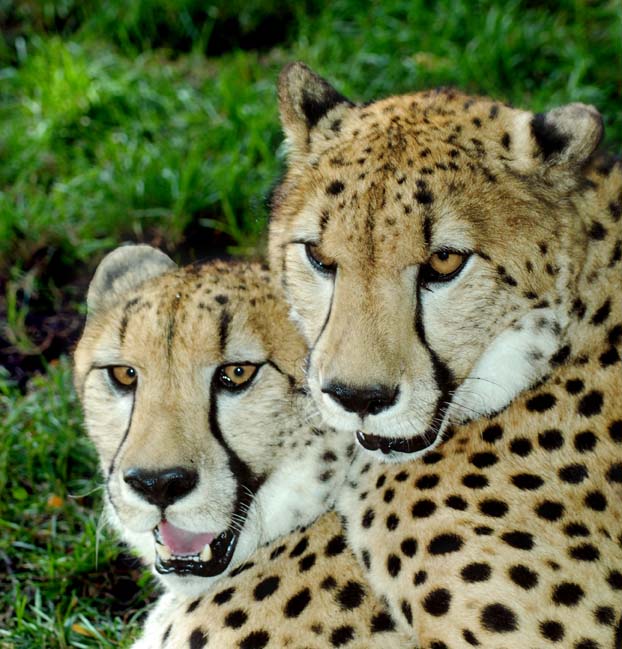
The spots are right, but the HEAD, it burns!
Well, there are several subspecies of cheetah (Acinonyx jubatus). They are not just native to Africa. Their range extends all the way to Iran, Pakistan, and perhaps India. The cheetah's name comes from the Hindi cita, so even if they are not still living in that area, they were there at one point.
The cheetah is meant for one thing: Speed. It lives up to its title of the fastest land animal alive, sprinting at speeds of up to 75 mph (120km/h). It has a slender body, long legs, a long tail, and fixed (as opposed to retractable) claws, a trait shared with only two other types of cat. (Its generic name, "Acinonyx," literally means "immobile claw.")
Do not let nature programs about superpredators fool you. There were tradeoffs when the cheetah became so specialized. Unlike other big cats, cheetahs cannot climb or roar; instead, they chirp. They may be one of the most successful hunters on the savannah, but because they run so fast, they often wind up exhausted after the kill. This gives other predators ample time to steal what they can of the cheetah's meal.
Essentially, cheetahs are feline greyhounds; they were used as such by aristocrats for hunting parties. How they domesticated the cats, I have no idea; cheetahs captured from the wild were preferable for hunting. This is the rough equivalent of catching a wolf and expecting it to listen to you.

Cheetah domestication goes as far back as ancient Egypt. The Mongols also had cheetahs at their disposal.
They are also in danger of dying out, and this time it is not mankind's fault. Sure, poaching does not help the issue, but for once, humans get away with a slap on the wrist.
For some reason -seriously, nobody knows why- cheetahs went through an evolutionary bottleneck. That means that there were so few individuals left that they had to resort to inbreeding to survive. This led to considerably reduced fertility and a genetic relationship so close that skin grafts from an unrelated cheetah will not be rejected by another.

So, uh...you two cousins or something?
Perhaps because of this genetic proximity, there is a 'tabby' mutation in cheetah species. These 'king cheetahs' were originally thought to be another subspecies. Then they found that the odd coat pattern was caused by the same gene that caused tabby stripes in normal house cats, removing much of the king cheetah's majesty. (The power of a morph at work, folks.)

A 'tabby' cheetah.
Given how closely related cheetahs are as a species, a mutation like the king cheetah is certainly welcome. As pointed out in my 'breed' segment, many traits tend to be linked together, such as hairlessness and dentition issues in dogs. For the cheetah, any mutation is a good mutation.
National Geographic dubbed the tigerfish "evolution on steroids." The cheetah is probably worthy of that title as well.

No comments:
Post a Comment